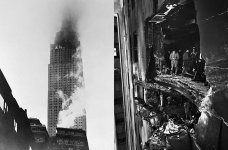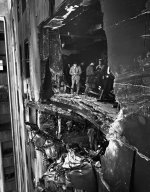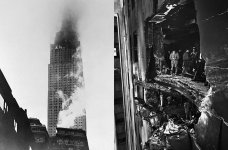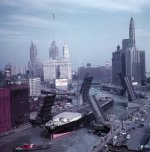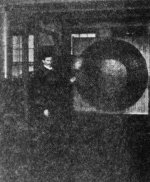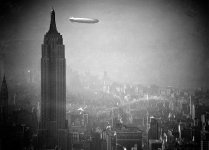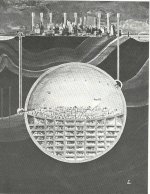Install the app
How to install the app on iOS
Follow along with the video below to see how to install our site as a web app on your home screen.
Note: This feature currently requires accessing the site using the built-in Safari browser.
You are using an out of date browser. It may not display this or other websites correctly.
You should upgrade or use an alternative browser.
You should upgrade or use an alternative browser.
Blast from the past
- Thread starter Administrator
- Start date
On Saturday, July 28, 1945, a B-25 Mitchell bomber traveling at 200 miles per hour (330 km/h) out of Massachusetts headed for Newark Airport got lost in dense fog and flew into floors 78 and 79 of New York City?s Empire State Building, the tallest building in the world at the time.
The accident caused the deaths of fourteen people (three crewmen and eleven people in the building) and damage estimated at US$1 million (at the time), although the building?s structural integrity was not compromised.
That day, Lieutenant Colonel William F. Smith Jr. was piloting a B-25 Mitchell bomber on a routine personnel transport mission from Bedford Army Air Field in Massachusetts to Newark Metropolitan Airport in New Jersey.
Smith asked for clearance to land, but he was advised of zero visibility Proceeding anyway, he became disoriented by the fog and turned right instead of left after passing the Chrysler Building.
At 9:40 a.m., the aircraft crashed into the north side of the Empire State Building, between the 78th and 80th floors, making an 18-by-20-foot (5.5 m by 6.1 m) hole in the building.
One engine shot through the south side opposite the impact, flew as far as the next block, dropped 900 feet (270 m), landed on the roof of a nearby building, and caused a fire that destroyed a penthouse art studio.
The other engine and part of the landing gear fell down an elevator shaft. The resulting fire was extinguished in 40 minutes.
Between 50 and 60 sightseers were on the 86th-floor observation deck when the crash happened. Fourteen people were killed: Colonel Smith, Staff Sergeant Christopher Domitrovich, and Navy Aviation Machinist?s Mate Albert Perna, who was hitching a ride, and eleven civilians in the building.
Perna?s body was not found until two days later when search crews discovered that it had entered an elevator shaft and fallen to the bottom. The other two crewmen were burned beyond recognition.
The accident caused the deaths of fourteen people (three crewmen and eleven people in the building) and damage estimated at US$1 million (at the time), although the building?s structural integrity was not compromised.
That day, Lieutenant Colonel William F. Smith Jr. was piloting a B-25 Mitchell bomber on a routine personnel transport mission from Bedford Army Air Field in Massachusetts to Newark Metropolitan Airport in New Jersey.
Smith asked for clearance to land, but he was advised of zero visibility Proceeding anyway, he became disoriented by the fog and turned right instead of left after passing the Chrysler Building.
At 9:40 a.m., the aircraft crashed into the north side of the Empire State Building, between the 78th and 80th floors, making an 18-by-20-foot (5.5 m by 6.1 m) hole in the building.
One engine shot through the south side opposite the impact, flew as far as the next block, dropped 900 feet (270 m), landed on the roof of a nearby building, and caused a fire that destroyed a penthouse art studio.
The other engine and part of the landing gear fell down an elevator shaft. The resulting fire was extinguished in 40 minutes.
Between 50 and 60 sightseers were on the 86th-floor observation deck when the crash happened. Fourteen people were killed: Colonel Smith, Staff Sergeant Christopher Domitrovich, and Navy Aviation Machinist?s Mate Albert Perna, who was hitching a ride, and eleven civilians in the building.
Perna?s body was not found until two days later when search crews discovered that it had entered an elevator shaft and fallen to the bottom. The other two crewmen were burned beyond recognition.
Attachments
In 1953, the biggest vessel to travel the Mississippi River and Illinois Waterway (at the time) managed to wind its way downtown on the Chicago River.
This steel hull behemoth was nearly 634 feet long (193m) and 70 feet wide (21.3m) and according to a Chicago Tribune account, the freighter had only seven inches of clearance on each side at Van Buren Street.
Even now, one has to gasp and wonder how the hell that happened. Luckily, we have these amazing old photographs to document the undertaking.
In the photo below, the Marine Angel executes the tight turn past the Wrigley Building and narrowly misses the side of the river where the Trump Tower now stands.
This steel hull behemoth was nearly 634 feet long (193m) and 70 feet wide (21.3m) and according to a Chicago Tribune account, the freighter had only seven inches of clearance on each side at Van Buren Street.
Even now, one has to gasp and wonder how the hell that happened. Luckily, we have these amazing old photographs to document the undertaking.
In the photo below, the Marine Angel executes the tight turn past the Wrigley Building and narrowly misses the side of the river where the Trump Tower now stands.
Attachments
Nikola Tesla was a Serbian American inventor, electrical engineer, mechanical engineer, and futurist best known for his contributions to the design of the modern alternating current electricity supply system.
Training for an engineering career, he attended the Technical University at Graz, Austria, and the University of Prague.
At Graz he first saw the Gramme dynamo, which operated as a generator and, when reversed, became an electric motor, and he conceived a way to use alternating current to advantage.
Later, at Budapest, he visualized the principle of the rotating magnetic field and developed plans for an induction motor that would become his first step toward the successful utilization of alternating current.
Training for an engineering career, he attended the Technical University at Graz, Austria, and the University of Prague.
At Graz he first saw the Gramme dynamo, which operated as a generator and, when reversed, became an electric motor, and he conceived a way to use alternating current to advantage.
Later, at Budapest, he visualized the principle of the rotating magnetic field and developed plans for an induction motor that would become his first step toward the successful utilization of alternating current.
Attachments
ozcopper said:1970s futuristic concept for jetliner air travel.
Looks like someone copied the idea.
https://www.youtube.com/watch?v=l7xaTp0lZSM
Reminds me of this.ozcopper said:A navigation system as imagined in the 1950s.
[youtube]https://youtu.be/4qqnHtH1RAs[/youtube]



